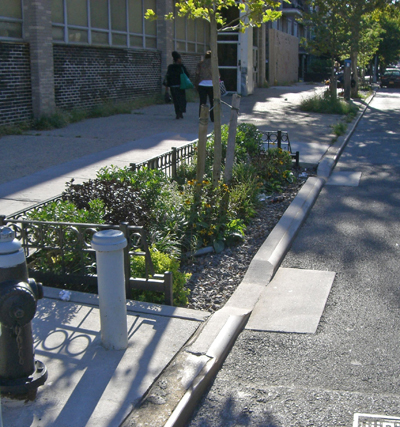 This is a story of livable streets and three public spaces in our community: Bartel Pritchard Square, the cul-de-sac on Fourth Street east of Fifth Avenue, and Grand Army Plaza.
This is a story of livable streets and three public spaces in our community: Bartel Pritchard Square, the cul-de-sac on Fourth Street east of Fifth Avenue, and Grand Army Plaza.
A nice, quiet transformation has taken place along the square at 15th Street and Prospect Park West, which honors two soldiers who died in World War I — Windsor Terrace native Emil Bartel and Bushwick native William Pritchard. For some time there has been a Greenmarket on Wednesdays at Bartel Pritchard’s entrance to Prospect Park, just past the two monumental columns that Pete Hamill called “the Totes,” in A Drinking Life, for what he thought was their resemblance to totem poles.
Nips and tucks in the roadway have calmed the traffic going around the traffic circle. Just recently, the city’s Department of Transportation (DOT) installed a traffic signal at the corner of 15th Street, making life for pedestrians a lot safer. The park entrance has been closed to motor vehicles for many years, creating an excellent and well-used portal for pedestrians, runners, and bicyclists. While Bartel Pritchard Square continues to sort out traffic to and from the streets leading to it, it has also become a better public space for the residents of Park Slope and Windsor Terrace.
(As to why this obvious circle is called a “square,” I’ve been baffled by that since I walked through there four times a day to and from first grade. The first person who e-mails me at mcairl@parkslopeciviccouncil.org with the correct or most plausible explanation why the circle is a square gets his or her choice of beverage and pastry from Connecticut Muffin, on Bartel Pritchard Square, courtesy of Yours Truly.)
Elsewhere in our neighborhood, the cul-de-sac on Fourth Street had been used primarily as parking for teachers at neighboring M.S. 51 and layovers for emergency vehicles. The renaissance of Fifth Avenue and the reconstruction of neighboring Washington Park presented an opportunity to put this dead-end street to better use. In the summer of 2010, the Civic Council commissioned a rendering of how the cul-de-sac might be transformed into a true public space. At the same time, the Park Slope Fifth Avenue Business Improvement District, the Civic Council, the Old Stone House, and M.S. 51 met with DOT to consider interim steps for the cul-de-sac. DOT responded with a time-honored solution, turning the cul-de-sac into a play street that’s closed to motor vehicles on weekdays.

The reconfigured space has been a success, and the Sunday Greenmarket on the Fifth Avenue side of Washington Park has now spilled over onto Fourth Street.
It’s time to look at taking the cul-de-sac to the next level. Washington Park has become a town square for Park Slope. Extending it to the doorstep of M.S. 51 and giving it over to the Greenmarket and other nontraffic purposes only makes sense to accommodate the many people and uses at this space.

The space might also be an ideal location for a swale that would capture storm water coming down Fourth Street and Fifth Avenue and keep at least some of it off of Fourth Avenue. Such a mechanism could be put into place all over Park Slope to help prevent flooding. Let’s get together around this project and see how far we can take it.
Our third space, Grand Army Plaza, has had a much less subtle transformation. The Grand Army Plaza Coalition (GAPCo) grew out of the Civic Council’s public forum on transportation in March 2006. The following year, DOT built up islands with plantings on the south end of the plaza, where previously there had been striped asphalt. In 2008 GAPCo and the Design Trust for Public Space put on “Reinventing Grand Army Plaza,” an exhibition that drew some 100,000 visitors, many of whom were in the plaza’s center oval for the first time. That same year, GAPCo established Friends of the Berms, a group of volunteers that each month clears away garbage and other debris from the berms (the planted areas along Plaza Street).
In 2010 and 2011, DOT undertook major changes at the north end of the plaza: reclaiming large areas of asphalt as raised planted areas, turning the junction of Flatbush and Vanderbilt Avenues into a traditional “diamond” intersection, regulating southbound traffic in the plaza, resurfacing the Greenmarket area, rationalizing the whole network of crosswalks, and much more.
This year has seen a first-in-New York City two-way, unprotected bike lane on Plaza Street. The Prospect Park Alliance has been an invaluable ally, placing and maintaining plantings in all the new spaces. And the result? Bicycle traffic is up, the number of people traversing the plaza on foot is way up, the Greenmarket has a distinct and undivided space, and the area between the Arch and the center oval is (more or less) off-limits to vehicles.
Soon, the monument to Abraham Lincoln that resides in Prospect Park’s Concert Grove will be moved to the area at Flatbush and Vanderbilt that has new plantings and park benches. There are more “tweaks” to come, particularly at the crossing by the Central Library, and the berm-side sidewalks on Plaza Street East need tender loving care.
Grand Army Plaza is a very different place than it was just six years ago. GAPCo — an umbrella group of civic groups, cultural organizations, and community boards — went a long way to make this transformation happen, entirely with volunteer labor. By succeeeding, GAPCo’s job is done. It’s now up to the “culturals,” Community Boards 6 and 8, the Alliance, and the general public to realize the great potential embodied in this space.
There is much more to be done all over the community to create truly livable streets and public spaces. The Civic Council’s relaunched Livable Streets Committee has an exciting agenda of near- and longer-term initiatives all over Park Slope. Our Forth on Fourth Avenue Committee and Sustainability Committee are in the mix, too.
The Park Slope Civic Council is our community’s most effective platform for civic engagement. Join us, and help create better public spaces for Park Slope.
— Michael Cairl is president of the Park Slope Civic Council.
from the October 2012 Civic News

